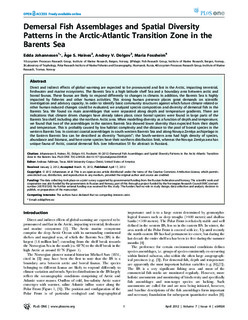| dc.contributor.author | Johannesen, Edda | |
| dc.contributor.author | Høines, Åge S. | |
| dc.contributor.author | Dolgov, Andrey V. | |
| dc.contributor.author | Fossheim, Maria | |
| dc.date.accessioned | 2012-12-03T12:15:25Z | |
| dc.date.available | 2012-12-03T12:15:25Z | |
| dc.date.issued | 2012-04-17 | |
| dc.identifier.issn | 1932-6203 | |
| dc.identifier.uri | http://hdl.handle.net/11250/109242 | |
| dc.description.abstract | Direct and indirect effects of global warming are expected to be pronounced and fast in the Arctic, impacting terrestrial,
freshwater and marine ecosystems. The Barents Sea is a high latitude shelf Sea and a boundary area between arctic and
boreal faunas. These faunas are likely to respond differently to changes in climate. In addition, the Barents Sea is highly
impacted by fisheries and other human activities. This strong human presence places great demands on scientific
investigation and advisory capacity. In order to identify basic community structures against which future climate related or
other human induced changes could be evaluated, we analyzed species composition and diversity of demersal fish in the
Barents Sea. We found six main assemblages that were separated along depth and temperature gradients. There are
indications that climate driven changes have already taken place, since boreal species were found in large parts of the
Barents Sea shelf, including also the northern Arctic area. When modelling diversity as a function of depth and temperature,
we found that two of the assemblages in the eastern Barents Sea showed lower diversity than expected from their depth
and temperature. This is probably caused by low habitat complexity and the distance to the pool of boreal species in the
western Barents Sea. In contrast coastal assemblages in south western Barents Sea and along Novaya Zemlya archipelago in
the Eastern Barents Sea can be described as diversity ‘‘hotspots’’; the South-western area had high density of species,
abundance and biomass, and here some species have their northern distribution limit, whereas the Novaya Zemlya area has
unique fauna of Arctic, coastal demersal fish. (see Information S1 for abstract in Russian). | no_NO |
| dc.language.iso | eng | no_NO |
| dc.publisher | PLoS ONE | no_NO |
| dc.subject | marine ecosystems | no_NO |
| dc.subject | marine økosystemer | no_NO |
| dc.subject | demersal fish | no_NO |
| dc.subject | bunnfisk | no_NO |
| dc.subject | climate change | no_NO |
| dc.subject | klimaendringer | no_NO |
| dc.title | Demersal Fish Assemblages and Spatial Diversity Patterns in the Arctic-Atlantic Transition Zone in the Barents Sea | no_NO |
| dc.type | Journal article | no_NO |
| dc.type | Peer reviewed | no_NO |
| dc.subject.nsi | VDP::Mathematics and natural science: 400::Zoology and botany: 480::Marine biology: 497 | no_NO |
| dc.subject.nsi | VDP::Mathematics and natural science: 400::Geosciences: 450::Oceanography: 452 | no_NO |
| dc.subject.nsi | VDP::Agriculture and fishery disciplines: 900::Fisheries science: 920::Fish health: 923 | no_NO |
| dc.subject.nsi | VDP::Social science: 200::Library and information science: 320::Knowledge retrieval and organization: 323 | no_NO |
| dc.source.pagenumber | e34924 | no_NO |
| dc.source.volume | 7 | no_NO |
| dc.source.journal | PLoS ONE | no_NO |
| dc.source.issue | 4 | no_NO |
| dc.identifier.doi | http://dx.doi.org/10.1371/journal.pone.0034924 | |
